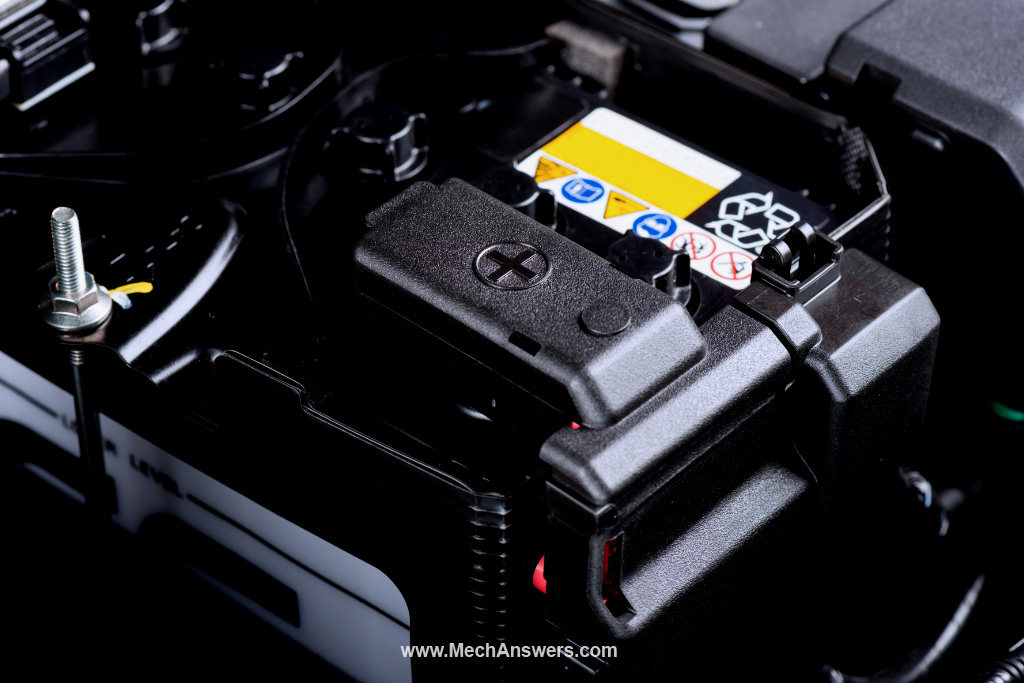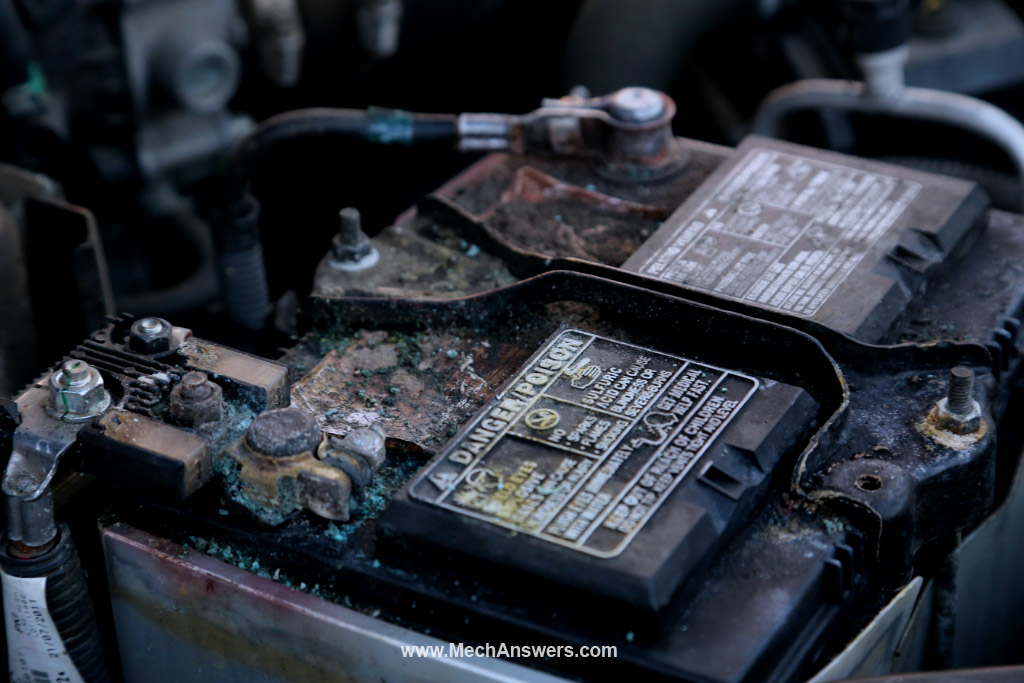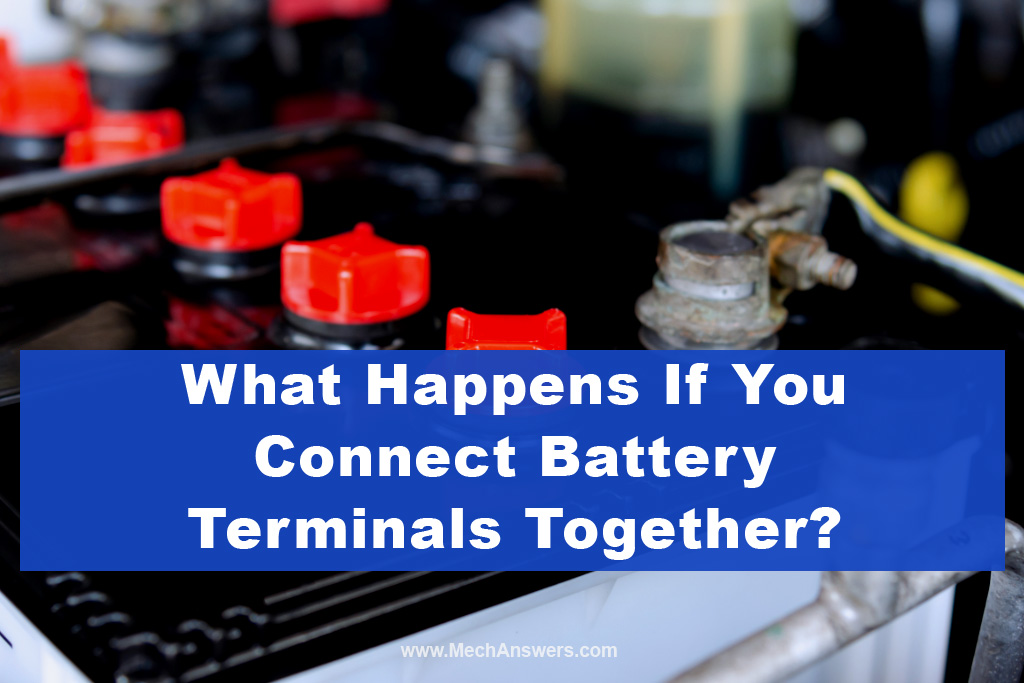Navigating through the myriad of queries surrounding car maintenance and safety, you may have stumbled upon the question, “What Happens If You Connect Battery Terminals Together?” If so, your search ends here.
So, what does happen if you connect battery terminals together? In short, connecting battery terminals together can create a short circuit, which leads to overheating, intense sparks, possible battery explosion, and severe damage to your vehicle’s electrical system.
This article will provide a comprehensive explanation of the potential consequences of such an action. Gaining this knowledge not only ensures better vehicle maintenance but also enhances your understanding of car safety measures, which is invaluable for every vehicle owner.
Table of Contents
How Are The Poles Arranged In A Car Battery?
The design and arrangement of the poles in a car battery are essential factors in the battery’s performance and its ability to power a vehicle. A car battery is composed of two poles, a positive and a negative, and the arrangement of these poles is critical to the battery’s safety and operation.
Understanding Battery Polarity
A car battery is made up of two poles, the positive and the negative. The positive pole is marked with a plus sign (+) and the negative pole is marked with a minus sign (-). The electrons that flow through the battery are attracted to the positive pole and repelled by the negative pole.
Positive and Negative Connections
When a car battery is in use, the positive pole is connected to the car’s electrical system, and the negative pole is connected to the car’s frame or engine block. This connection is essential for the battery to function properly.
Arrangement of Poles
The arrangement of the poles in a car battery is important for the battery to work safely and effectively. Typically, the positive pole is located in the center of the battery and the negative pole is located on the outside.
This arrangement ensures that the positive pole is the first to make contact when the battery is connected to the car’s electrical system. This prevents any sparks or short circuits which can damage the battery or the car.
The arrangement of the poles in a car battery is critical to its performance and safety. The positive pole should always be in the center and the negative pole should be on the outside to ensure that the battery is able to operate correctly and without any risk of sparking or short circuits.

What Happens If You Connect Battery Terminals Together? 10 Effects
Intense Sparks:
One of the immediate effects of connecting battery terminals together is the generation of intense sparks. This is due to the sudden high current flow between the positive and negative terminals, creating a short circuit.
This not only poses a fire risk but could also lead to the battery exploding if the sparks come into contact with any flammable substances or gases that might be present near the battery.
Battery Overheating:
The short circuit caused by connecting battery terminals together will result in a sudden surge of current flow. This can lead to rapid overheating of the battery. Overheating can cause the battery to swell, leak, or in extreme cases, even explode.
Battery Explosion:
In worst-case scenarios, connecting the battery terminals together could lead to the battery exploding. The sparks produced can ignite the hydrogen gas that batteries emit, causing a violent explosion. This can result in serious injury or even death, and it will certainly destroy the battery.
Damage to the Battery Itself:
In addition to causing a possible explosion, connecting the terminals of a battery can severely damage the battery itself. The internal components of the battery can melt or deform due to the heat produced, rendering the battery useless.
Electrical System Damage:
Your car’s electrical system could also be at risk if you connect battery terminals together. The surge of current can burn out fuses, damage electronic components, and potentially cause irreparable damage to the car’s electrical system.
Alternator Damage:
The alternator, which charges the battery while the engine is running, can also be damaged by the sudden surge of electricity. This could lead to costly repairs and leave the car unable to run until the alternator is replaced or repaired.
Damage to Connected Devices:
Any devices connected to the car’s electrical system at the time could also be damaged. This could include the car’s onboard computers, lighting system, radio, and any other connected accessories.
Fire Hazard:
The sparks caused by connecting battery terminals together can easily ignite flammable liquids or gases in the area. If this happens in a garage or near other vehicles or structures, it could start a larger fire causing significant property damage.
Injury to Persons:
Connecting battery terminals together not only poses risks to the vehicle but also to people. Anyone close by when the terminals are connected could be injured by sparks, acid, or debris if the battery explodes.
Battery Acid Leakage:
If the battery becomes damaged, it could begin to leak battery acid. This acid is highly corrosive and can cause damage to other parts of the car. It’s also harmful to the skin and can be hazardous to the environment.
Remember, it’s essential to follow safety procedures when working with car batteries to avoid these risks. Always connect and disconnect the terminals properly, and consider consulting with a professional if you’re unsure.
How To Recognize The Correct Terminal In A Car Battery?
Modern cars are becoming increasingly complex, making it difficult to identify and diagnose problems. One such problem is the incorrect installation of a car battery terminal. This article will explain how to recognize the correct terminal in a car battery and the importance of correct installation.
What is a Terminal?
A terminal is a metal connector that attaches the battery to the car’s electrical system. The terminal has two parts: the positive terminal and the negative terminal. Both need to be securely attached and correctly installed in order to ensure the proper functioning of the car.
Signs of an Incorrectly Installed Terminal
Incorrectly installed terminals can cause the car to malfunction and can even lead to dangerous conditions. To avoid these issues, it’s important to know how to recognize an incorrectly installed terminal. Here are some signs that may indicate an incorrectly installed terminal:
- Corrosion: Corrosion on the terminals can indicate a poor connection or a loose connection, both of which can cause the car to malfunction.
- Loose terminal: A loose terminal can cause the car to malfunction and can also be dangerous.
- Discolored terminal: If the terminal appears discolored or has a different color than the other terminal, it may indicate an incorrect installation.
- How to Recognize a Correct Terminal: In order to ensure the correct installation of a terminal, it’s important to look for the following signs:
- Tight connection: The terminal should be securely attached to the battery.
- Clean terminals: The terminals should be free of corrosion and other contaminants.
- Color: The positive terminal should be red and the negative terminal should be black.
It’s important to recognize the correct terminal in a car battery in order to ensure the proper functioning of the car.
By looking for the signs of an incorrectly installed terminal and by ensuring that the terminals are securely attached and free of corrosion and contaminants, you can ensure that your car is running safely and efficiently.
What If You Have To Deal With Unmarked Battery Cables?
Dealing with unmarked battery cables is not an easy task for any individual. It can be especially challenging for those who are not experienced in working with electrical components.
However, with the right knowledge, it is possible to identify and properly mark the cables. This article will provide an overview of the steps involved in dealing with unmarked battery cables, as well as advice on how to ensure the safety of yourself and others when doing so.
Identifying Unmarked Battery Cables
If you find yourself dealing with unmarked battery cables, it can be difficult to determine which cable attaches to the positive and negative terminals. Fortunately, there are some ways to identify unmarked battery cables.
Check for Color Coding
The most common way to identify unmarked cables is to look for color coding. Red cables typically signify the positive terminal, while black cables indicate the negative terminal.
Look for Striped Cables
Some cables come with striped insulation, with the red stripe indicating the positive terminal and the black stripe indicating the negative terminal.
Measure the Cable Lengths
If the cables are identical in length, it can be difficult to identify which cable attaches to the positive and negative terminals.
In this case, you can measure the cables and note their lengths. The cable with the longer length is typically the positive terminal, while the cable with the shorter length is typically the negative terminal.
Check the Connector End
If the cables have different connector ends, then the cable with the flat connector is typically the negative terminal, while the cable with the pointed connector is typically the positive terminal.
Test the Cables
If all else fails, you can test the cables to identify which cable attaches to the positive and negative terminals. Connect a voltmeter to the terminals and note the readings.
The cable with the positive reading is typically the positive terminal, while the cable with the negative reading is typically the negative terminal.

Proving You Didn’t Damage The Battery
If you are accused of damaging a battery by connecting the terminals together, there are a few steps you can take to prove your innocence. Knowing how to prove that you didn’t cause the battery to malfunction can save you money, time, and hassle.
Check the battery
The first step to proving your innocence is to check the battery itself. It’s possible that the battery was already damaged before you touched it. Look for signs of corrosion or any other damage that may indicate that the battery was already faulty before you handled it.
Gather Evidence
The next step is to collect any evidence that could prove your innocence. If you have any witnesses who can testify that you didn’t put the terminals together, make sure to contact them. Additionally, take pictures of the battery that you can use as evidence in court.
Seek Legal Advice
If you are accused of damaging the battery, it’s important to seek legal advice. An experienced attorney will be able to advise you on the best course of action to take and help you prove your innocence. Make sure to seek legal advice as soon as possible after the incident to ensure that your rights are protected.
How You Can Safely Disconnect The Battery Cables?
How to safely disconnect battery cables
Whether you’re replacing your car’s battery or doing some electrical work, it’s important to know how to safely disconnect your car’s battery cables. If done incorrectly, it can cause serious damage to your vehicle’s electrical system and potentially result in a fire. Here’s how to do it right.
Preparing to disconnect
Before you start, make sure you have the right tools. You’ll need a wrench or socket set. You may also need a pair of pliers to loosen the nuts that secure the cable clamps. Make sure the engine is off and the ignition key is removed.
Locate the battery
The battery is usually located in the engine compartment and is easy to spot. It’s a large metal box with two posts on the top.
Disconnect the negative cable
The negative cable is usually black and is marked with a “-”. Start by loosening the cable clamp nut with a wrench or socket. Once the nut is loose, remove the cable from the negative post.
Disconnect the positive cable
The positive cable is usually red and is marked with a “+”. Again, start by loosening the nut with a wrench or socket. Once the nut is loose, remove the cable from the positive post.
Reconnecting the battery
When reconnecting the battery, start by connecting the positive cable to the positive post. Make sure the nut is tight. Then, connect the negative cable to the negative post. Make sure the nut is tight.
It’s important to know how to safely disconnect your car’s battery cables. Always make sure you have the right tools and that the engine is off and the ignition key is removed before disconnecting.
Start by loosening the cable clamp nuts and then disconnect the negative cable first and the positive cable second. When reconnecting, start with the positive cable and then the negative cable. Following these steps will ensure a safe and secure process.
How To Connect Jumper Cables Correctly Not To Cause Any Damage?
How does jumpstarting a car work?
Jumpstarting a car is a simple process that can help get a car out of a bind when the battery is drained. This technique can be used to provide the battery with enough charge to crank the engine and get the car running.
The jumpstarting process
The first step in jumpstarting a car is to connect the two batteries with jumper cables. This requires connecting a red cable to each battery’s positive terminal, and a black cable to each battery’s negative terminal.
Once the cables are connected, the battery of the working car should be used to jumpstart the car with the dead battery. To do this, the working car should be started and allowed to idle for a few minutes. This will allow the charge to jump from the working car’s battery to the dead car’s battery.
Once the charge has been transferred, the engine of the car with the dead battery can be tried to crank. If the engine cranks, the car should start and be able to run as normal. If the engine does not start, the process should be repeated or the car taken to a professional mechanic.
Jumpstarting a car is a simple process that can help get you out of a bind when the battery is dead. With the right equipment and a few simple steps, you can get the car running and back on the road.
Here is a step-by-step guide to connecting jumper cables correctly.
Gather the Necessary Supplies
Before connecting the cables, you will need to gather the supplies. You will need the following:
– Jumper cables
– Another car with a working battery
– Safety gloves
– Safety glasses
Preparing the cars
Once you have the necessary supplies, you can begin connecting the jumper cables. Start by parking both cars close together and make sure each car is in neutral and the parking brake is engaged. Pop the hoods of both cars and locate the batteries.
Connect the jumper cables
Next, you will need to connect the jumper cables. Start by connecting the red clamp to the positive terminal of the dead battery. Then, connect the other red clamp to the positive terminal of the working battery.
Now, connect the black clamp to the negative terminal of the working battery. Finally, connect the other black clamp to an unpainted metal surface on the car with the dead battery. Do not connect the clamp to the negative terminal of the dead battery.
Start the Car
Once the cables are connected, you can try to start the car with the dead battery. Start the car with the working battery first, then attempt to start the car with the dead battery. If the car with the dead battery starts, let it run for a few minutes to allow the battery to charge.
Disconnect the jumper cables
Once the car with the dead battery is running, you can disconnect the jumper cables. Start by disconnecting the black clamp from the unpainted metal surface.
Then, disconnect the other black clamp from the negative terminal of the working battery. Next, disconnect the red clamp from the positive terminal of the working battery. Finally, disconnect the other red clamp from the positive terminal of the dead battery.
Connecting jumper cables correctly can be a lifesaver in a pinch. With the right supplies and a bit of know-how, you can get a dead battery started in no time. Just remember to always wear safety gloves and glasses to protect yourself.#
What Happens If I Connect Battery Plus Cable And Minus Cables Together…? >> Check out the video below:
Related Articles
Read more >> What Causes Brake Light On Dash To Stay On? Top 15 Causes!
Read more >> SOS Dashboard:12 Causes Why Your Dashboard Light Stays On!
Read more >> Why Is One Headlight Not Working? (10 Causes & Solutions!)
Read more >> Why Do I Have To Jump My Car Every Time I Turn It Off?
Read more >> Is It Bad To Jumpstart A Car Everyday? (Your Safety Guide!)
Read more >> Will Adding Water To A Battery Fix It? (Read this!)
Read more >> What Happens If Car Battery Is Low On Water?
Conclusion
Overall, connecting battery terminals together can be dangerous and cause damage to the battery and any related components. It can also cause a fire or explosion if the battery is damaged in the process.
It’s important to take all necessary safety precautions before attempting to connect battery terminals. It’s also important to ensure that the battery is in good condition before making a connection.
It’s best to consult an experienced electrician or mechanic if you’re unsure of what you’re doing. If done correctly, connecting battery terminals together can be a safe and effective method of charging or powering a device or even jump-starting a car.

